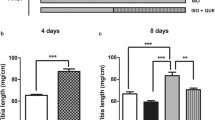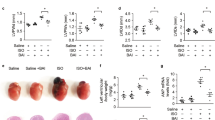Abstract
Quercetin is a ubiquitous flavonoid found in vegetable foods. Epidemiological and animal studies have reported an inverse association between quercetin intakes and occurrence and development of various cardiovascular diseases. Some researchers have inferred that the mechanisms of quercetin to protect cardiomyocytes from ischemia/reperfusion injury may be involved in modulation of intracellular signal pathways and regulation of proteins expression beyond its antioxidant activity. The aim of this study was to investigate whether quercetin protect cardiomyocytes from anoxia/reoxygenation injury through PKCε pathway. Neonatal rat primary cardiomyocytes were pretreated with quercetin or quercetin plus εV1-2, a selective PKCε inhibitor, prior to A/R treatment. Western blotting analysis showed that the level of PKCε and phosphor-PKCε Ser297 in the quercetin pretreatment group were all increased significantly compared to the control or A/R group. Subsequent assays showed that pretreated with quercetin could increase the viability of neonatal rat primary cardiomyocytes suffered A/R, decrease the apoptosis and ROS and alleviate the loss of mitochondrial membrane potential induced by A/R injury. However, the protective effects of quercetin disappeared in the group pretreated with εV1-2. Thus, for the first time, we revealed that one of the mechanisms of quercetin protecting cardiomyocytes from A/R injury might be increase the expression of PKCε protein and then enhance the activity of its downstream pathway.






Similar content being viewed by others
References
Kelly GS (2011) Quercetin. Monograph. Altern Med Rev 16(2):172–194
Hwang IK, Lee CH, Yoo KY, Choi JH, Park OK, Lim SS, Kang IJ, Kwon DY, Park J, Yi JS, Bae YS, Won MH (2009) Neuroprotective effects of onion extract and quercetin against ischemic neuronal damage in the gerbil hippocampus. J Med Food 12(5):990–995. doi:10.1089/jmf.2008.1400
Annapurna A, Reddy CS, Akondi RB, Rao SR (2009) Cardioprotective actions of two bioflavonoids, quercetin and rutin, in experimental myocardial infarction in both normal and streptozotocin-induced type I diabetic rats. J Pharm Pharmacol 61(10):1365–1374. doi:10.1211/jpp/61.10.0014
Huk I, Brovkovych V, Nanobash Vili J, Weigel G, Neumayer C, Partyka L, Patton S, Malinski T (1998) Bioflavonoid quercetin scavenges superoxide and increases nitric oxide concentration in ischemia–reperfusion injury: an experimental study. Br J Surg 85(8):1080–1085. doi:10.1046/j.1365-2168.1998.00787.x
Mojzis J, Hviscova K, Germanova D, Bukovicova D, Mirossay L (2001) Protective effect of quercetin on ischemia/reperfusion-induced gastric mucosal injury in rats. Physiol Res 50(5):501–506
Kahraman A, Erkasap N, Serteser M, Koken T (2003) Protective effect of quercetin on renal ischemia/reperfusion injury in rats. J Nephrol 16(2):219–224
Su JF, Guo CJ, Wei JY, Yang JJ, Jiang YG, Li YF (2003) Protection against hepatic ischemia–reperfusion injury in rats by oral pretreatment with quercetin. Biomed Environ Sci 16(1):1–8
Hertog MG, Feskens EJ, Hollman PC, Katan MB, Kromhout D (1993) Dietary antioxidant flavonoids and risk of coronary heart disease: the Zutphen Elderly Study. Lancet 342(8878):1007–1011
Knekt P, Jarvinen R, Reunanen A, Maatela J (1996) Flavonoid intake and coronary mortality in Finland: a cohort study. BMJ 312(7029):478–481
Kinaci MK, Erkasap N, Kucuk A, Koken T, Tosun M (2012) Effects of quercetin on apoptosis, NF-kappaB and NOS gene expression in renal ischemia/reperfusion injury. Exp Ther Med 3(2):249–254
Wan LL, Xia J, Ye D, Liu J, Chen J, Wang G (2009) Effects of quercetin on gene and protein expression of NOX and NOS after myocardial ischemia and reperfusion in rabbit. Cardiovasc Ther 27(1):28–33
Jin HB, Yang YB, Song YL, Zhang YC, Li YR (2012) Protective roles of quercetin in acute myocardial ischemia and reperfusion injury in rats. Mol Biol Rep 39(12):11005–11009
Zhang N, Pei F, Wei H, Zhang T, Yang C, Ma G (2011) Isorhamnetin protects rat ventricular myocytes from ischemia and reperfusion injury. Exp Toxicol Pathol 63(1–2):33–38
Ikizler M, Erkasap N, Dernek S, Kural T, Kaygisiz Z (2007) Dietary polyphenol quercetin protects rat hearts during reperfusion: enhanced antioxidant capacity with chronic treatment. Anadolu Kardiyol Derg 7(4):404–410
Watkins SJ, Borthwick GM, Arthur HM (2010) The H9C2 cell line and primary neonatal cardiomyocyte cells show similar hypertrophic responses in vitro. In Vitro Cell Dev Biol Anim 47(2):125–131. doi:10.1007/s11626-010-9368-1
Murphy E, Steenbergen C (2008) Mechanisms underlying acute protection from cardiac ischemia–reperfusion injury. Physiol Rev 88(2):581–609. doi:10.1152/physrev.00024.2007
Pandey AK, Verma S, Bhattacharya P, Paul S, Mishra A, Patnaik R (2012) An in silico strategy to explore neuroprotection by quercetin in cerebral ischemia: a novel hypothesis based on inhibition of matrix metalloproteinase (MMPs) and acid sensing ion channel 1a (ASIC1a). Med Hypotheses 79(1):76–81
Yao RQ, Qi DS, Yu HL, Liu J, Yang LH, Wu XX (2012) Quercetin attenuates cell apoptosis in focal cerebral ischemia rat brain via activation of BDNF-TrkB-PI3K/Akt signaling pathway. Neurochem Res 37(12):2777–2786
Gruber JV, Holtz R (2010) Examining the genomic influence of skin antioxidants in vitro. Mediators Inflamm. doi:10.1155/2010/230450
Miura T, Tanno M, Sato T (2010) Mitochondrial kinase signalling pathways in myocardial protection from ischemia/reperfusion-induced necrosis. Cardiovasc Res 88(1):7–15. doi:10.1093/cvr/cvq206
Kim JA, Jung YS, Kim MY, Yang SY, Lee S, Kim YH (2011) Protective effect of components isolated from Lindera erythrocarpa against oxidative stress-induced apoptosis of H9c2 cardiomyocytes. Phytother Res 25(11):1612–1617. doi:10.1002/ptr.3465
Lu N, Zhang Y, Gao Z (2009) Nitrite-glucose-glucose oxidase system directly induces rat heart homogenate oxidation and tyrosine nitration: effects of some flavonoids. Toxicol In Vitro 23(4):627–633. doi:10.1016/j.tiv.2009.02.013
Griffiths EJ (2012) Mitochondria and heart disease. Adv Exp Med Biol 942:249–267. doi:10.1007/978-94-007-2869-1_11
Angst E, Park JL, Moro A, Lu QY, Lu X, Li G, King J, Chen M, Reber HA, Go VL, Eibl G, Hines OJ (2012) The flavonoid quercetin inhibits pancreatic cancer growth in vitro and in vivo. Pancreas 20:20
Castillo-Pichardo L, Dharmawardhane SF (2012) Grape polyphenols inhibit Akt/mammalian target of rapamycin signaling and potentiate the effects of gefitinib in breast cancer. Nutr Cancer 64(7):1058–1069
Chuang-Xin L, Wen-Yu W, Yao C, Xiao-Yan L, Yun Z (2012) Quercetin enhances the effects of 5-fluorouracil-mediated growth inhibition and apoptosis of esophageal cancer cells by inhibiting NF-kappaB. Oncol Lett 4(4):775–778
Acknowledgments
This work was supported by 973 projects (2009CB526405) to H.M. and Natural Science Foundation of China (81260492) to T.L.
Author information
Authors and Affiliations
Corresponding author
Additional information
Lei Tang and Yian Peng have contributed equally to this study.
Rights and permissions
About this article
Cite this article
Tang, L., Peng, Y., Xu, T. et al. The effects of quercetin protect cardiomyocytes from A/R injury is related to its capability to increasing expression and activity of PKCε protein. Mol Cell Biochem 382, 145–152 (2013). https://doi.org/10.1007/s11010-013-1729-0
Received:
Accepted:
Published:
Issue Date:
DOI: https://doi.org/10.1007/s11010-013-1729-0




